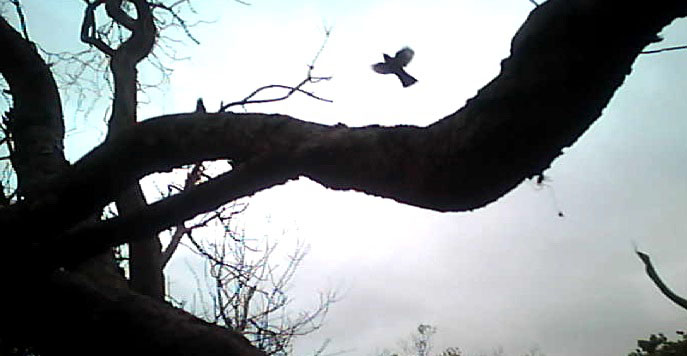The Secret Life of Wellington Cats
Our ten week cat-cam pilot study to investigate the wild diets of our cats, their foraging habits and general behaviour has given us several interesting insights into the world of our cats.

A still from one of the cat-cams. Although there was no predation of birds, tracking behaviours like this and even the presence of cats will deter birds from nesting.
Domestic cats are creatures that live so closely to us, and yet – in NZ at least – studies have been limited. Indeed, this cat-cam study was a NZ first!
The study – initiated by postdoctoral fellow Heidy Kikillus – followed the lives of ten cats living around the neighbourhood near the sanctuary Zealandia (Northland, Highbury, Kelburn, Karori).
Each cat has been fitted with a motion-sensitive camera that was turned on either during the day or at night by their owners to give us a two-hour snapshot of their behaviour.
I analysed approximately eighty hours of footage and the behaviour of the cat was coded into a variety of categories – from predation to locomotion, grooming to ingestion.
“Investigation” (which included staring at things, such as birds, and sniffing objects etc) was the most common behaviour exhibited by the cats, leading us to wonder if perhaps curiosity does kill the cat!

Total behaviours exhibited by 10 domestic cats over an eight week period monitored by Eyenimal TM Cat Videocams in Wellington, New Zealand
Despite predictions, no bird or rodent slaughter footage was captured on camera – although we did receive a report from one owner of a bird and a mouse being brought home by their cat off camera.
Invertebrates and native lizards appeared to be the food of choice for our study cats. Four lizards were caught and eaten on film (3 skinks and 1 gecko) and we also received 2 separate reports of a lizard being brought home off camera during the study period.
New Zealand’s elusive native lizards often aren’t afforded the same affection as we give to our native birds – but our unique lizards are a fundamental component of New Zealand’s biodiversity and ensuring their survival is vital.
Our study didn’t mimic the results of overseas studies which have showed a higher kill rate however this could be put down to the small sample size, the limited 2 hour recordings and the fact that the camera may have acted as a hunting deterrent – much in the same way that cat-bibs have been shown to reduce predation.
If we can source more funding, we would like to embark on a larger more comprehensive study that will allow us to use GPS trackers to find out the range of our domestic cats and to see whether they stray into conservation areas.
Additionally with the use of a smartphone application, owners could monitor their cat’s kill rate over a longer period to help us build a database.
Given that technology is becoming cheaper, lighter and increasingly bespoke, no doubt there will be a range of tools that we can use to build a rich picture of our cats secret lives in the near future.
Would you like to know where your moggy roams? How big is your cats’ home range? If you are interested in learning more about this project, or possibly participating in future studies, please contact Heidy at Heidy.Kikillus@vuw.ac.nz.
